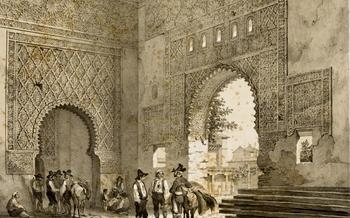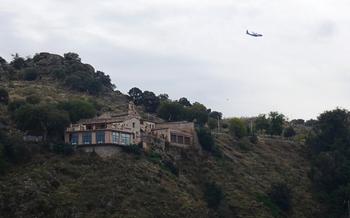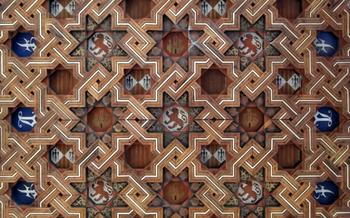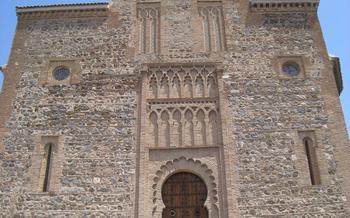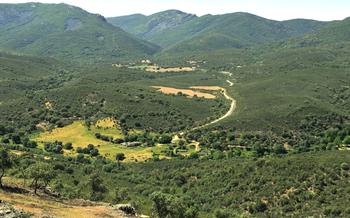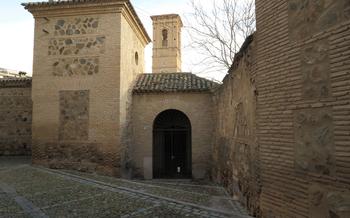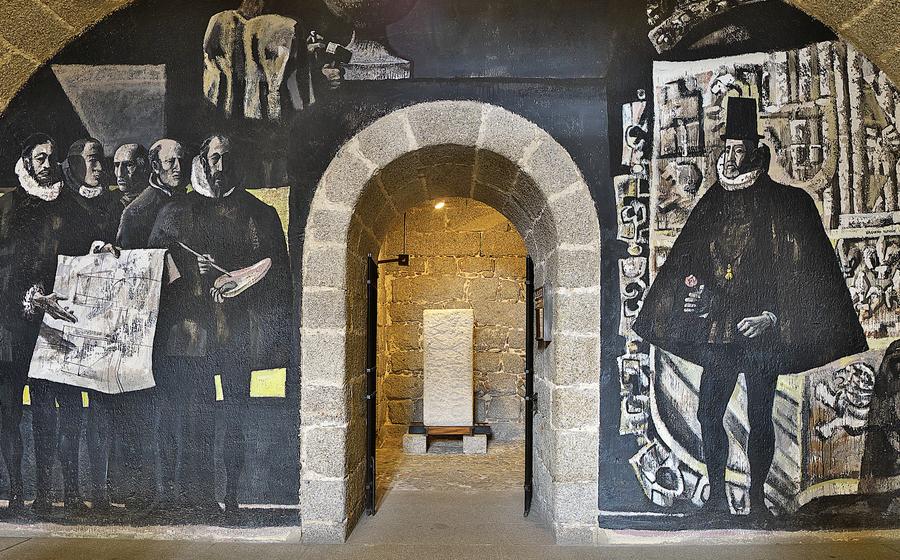
The Monastery of San Bartolomé
- The Monastery of San Bartolomé: A Hidden Gem in Toledo
- Location and Accessibility: Finding the Monastery
- Historical Overview: Unveiling the Past
- Architectural Splendor: Exploring the Monastery's Design
- Courtyard and Gardens: A Haven of Tranquility
- Church of San Bartolomé: A Sacred Space
- Cloister: A Place of Serenity
- Bell Tower: A Majestic Landmark
- Museum of Visigothic Art: A Hidden Treasure
- Cultural Events and Activities: Bringing History to Life
- Guided Tours: Unraveling the Monastery's Secrets
- Photography and Videography: Capturing the Beauty
- Accessibility for Visitors with Disabilities
- Nearby Attractions: Exploring Toledo's Treasures
- Insider Tip: Discovering the Hidden Chapel
The Monastery of San Bartolomé: A Hidden Gem in Toledo
Nestled amidst the enchanting streets of Toledo, Spain, the Monastery of San Bartolomé stands as a testament to the city's rich history and architectural heritage. Founded in the 12th century, the monastery played a pivotal role during the Reconquista, serving as a refuge for Christian knights and a strategic stronghold against the invading Moors. Its strategic location atop a hill overlooking the Tagus River afforded a panoramic view of the surrounding landscape, making it a crucial defensive position.
Over the centuries, the monastery underwent several expansions and modifications, blending Gothic, Renaissance, and Mudejar elements into a harmonious architectural ensemble. The result is a stunning masterpiece that seamlessly merges diverse artistic influences, creating a unique and captivating visual experience.
Inside the monastery, visitors are greeted by a treasure trove of notable artwork and artifacts. The church boasts an exquisite altarpiece, intricate carvings, and vibrant stained-glass windows that narrate biblical stories and depict scenes from the lives of saints. The monastery's collection also includes valuable manuscripts, paintings, and sculptures, each piece contributing to the rich cultural heritage of this sacred site.
Recognized for its exceptional historical and artistic significance, the Monastery of San Bartolomé has been designated as a Bien de Interés Cultural, a protected cultural heritage site in Spain. This designation ensures the preservation and appreciation of this architectural gem for generations to come, allowing visitors to delve into the depths of Toledo's storied past and experience the enduring legacy of its religious and cultural heritage.
Location and Accessibility: Finding the Monastery
The Monastery of San Bartolomé is situated in the heart of Toledo's historic center, a mere stone's throw from the iconic Toledo Cathedral. Its exact address is Calle del Angel, 1, 45002 Toledo, Spain. To reach the monastery, visitors can embark on a pleasant stroll through the narrow cobbled streets of Toledo, soaking in the city's medieval charm. Alternatively, they can opt for public transportation, with several bus lines stopping nearby. For those arriving by car, limited parking is available in the vicinity.
Situated in close proximity to other prominent landmarks, the Monastery of San Bartolomé offers an excellent starting point for exploring Toledo's rich cultural heritage. The captivating Jewish Quarter, with its labyrinthine alleys and historic synagogues, lies just a short walk away. The Alcázar of Toledo, a magnificent fortress that once served as a royal palace, is also within easy reach. By combining a visit to the monastery with these nearby attractions, visitors can create a comprehensive and enriching itinerary that unveils the multifaceted history and beauty of Toledo.
Historical Overview: Unveiling the Past
The Monastery of San Bartolomé holds a significant place in the rich tapestry of Toledo's history. Founded in the 12th century by the Knights Hospitaller, a religious-military order, the monastery played a crucial role during the Reconquista, the Christian reconquest of the Iberian Peninsula from Muslim rule. The knights used the monastery as a base of operations, providing shelter, medical care, and spiritual guidance to the Christian soldiers fighting in the region.
Over the centuries, the monastery underwent several changes and additions, reflecting the evolving needs and tastes of its occupants. In the 14th century, the Gothic-Mudejar cloister was added, blending Islamic and Christian architectural elements to create a unique and visually stunning space. The bell tower, a prominent landmark of the monastery, was constructed in the 15th century, serving as a watchtower and a symbol of the monastery's power and influence.
In the 19th century, the monastery was declared a national monument, recognizing its historical and cultural significance. Today, it stands as a testament to the rich heritage of Toledo, attracting visitors from around the world who come to admire its architectural splendor, explore its fascinating history, and experience the spiritual tranquility that permeates its walls.
Architectural Splendor: Exploring the Monastery's Design
The Monastery of San Bartolomé stands as an exquisite example of the Gothic-Mudejar architectural style. This unique blend of Gothic and Mudejar influences is evident throughout the monastery's structure. The exterior boasts intricate brickwork and decorative elements that showcase the Mudejar heritage. The interior, on the other hand, displays Gothic features such as pointed arches and ribbed vaults.
One of the most captivating elements of the monastery is its cloister. Its serene courtyard is surrounded by elegant arches and columns, adorned with intricate carvings and decorative tiles. The central fountain adds to the tranquility of the space, creating a peaceful atmosphere conducive to contemplation and reflection.
The bell tower is another notable feature of the monastery. Its imposing height and sturdy construction make it a prominent landmark in the Toledo skyline. The tower's design showcases the ingenuity of its builders, with its intricate stone carvings and delicate tracery. Its historical significance as a watchtower adds to its charm, as it once served as a strategic vantage point for spotting potential threats.
The architectural splendor of the Monastery of San Bartolomé is further enhanced by its rich symbolism and iconography. Religious motifs, biblical scenes, and intricate patterns adorn the walls, columns, and arches, providing visitors with a glimpse into the beliefs and values of the medieval period.
A comparison with other religious buildings in Toledo reveals the distinct character of the Monastery of San Bartolomé. While sharing some similarities with the Gothic-Mudejar style seen in other churches and monasteries, the Monastery of San Bartolomé stands out with its unique blend of architectural elements and its serene ambiance. It represents a harmonious fusion of different artistic traditions, reflecting the rich cultural heritage of Toledo.
Courtyard and Gardens: A Haven of Tranquility
The courtyard of the Monastery of San Bartolomé offers a serene and tranquil oasis amidst the bustling streets of Toledo. Designed with meticulous care and attention to detail, the courtyard features a harmonious layout that exudes a sense of peace and tranquility.
At the center lies a beautiful fountain, its gentle waters trickling softly, creating a soothing ambiance that invites visitors to pause and reflect. Surrounding the fountain are verdant gardens, meticulously landscaped with a variety of colorful flowers, aromatic herbs, and shady trees.
Stone benches and seating areas are strategically placed throughout the courtyard, providing visitors with comfortable spots to rest, relax, and soak in the serene atmosphere. The gentle rustling of leaves and the sweet chirping of birds create a symphony of natural sounds that further contribute to the courtyard's tranquility.
Beyond its aesthetic beauty, the courtyard also holds historical significance. In the past, it served as a place for monks to gather, meditate, and engage in religious contemplation. Today, it continues to be a sacred space, offering visitors a respite from the hustle and bustle of the city, inviting them to find solace and reconnect with their spiritual side.
Church of San Bartolomé: A Sacred Space
The Church of San Bartolomé, the heart of the monastery, invites visitors to immerse themselves in its sacred atmosphere. Step inside to be greeted by an interior that exudes both grandeur and tranquility. The layout is typical of Gothic architecture, with a nave and two aisles separated by rows of elegant columns. The high vaulted ceiling creates a sense of awe-inspiring spaciousness.
Admire the intricate altarpiece, a masterpiece of Gothic art. Its finely carved panels depict scenes from the life of Christ and the saints, inviting contemplation and reverence. The stained glass windows, with their vibrant colors and intricate designs, cast a warm and ethereal glow throughout the church, adding to its spiritual ambiance.
Notable artwork adorns the walls and side chapels, each piece telling a story of faith and devotion. Paintings by renowned Spanish artists, such as El Greco and Luis Tristán, depict religious scenes with a realism and emotional depth that captivate the viewer. Sculptures of saints and angels, carved with exquisite detail, seem to come to life, inspiring awe and devotion.
Cloister: A Place of Serenity
The cloister, the heart of the Monastery of San Bartolomé, is a masterpiece of Gothic-Mudejar architecture. Its elegant arches, supported by slender columns, create a serene and contemplative atmosphere. The intricate carvings adorning the capitals and spandrels showcase the artistic prowess of the craftsmen who built this sacred space.
In the center of the cloister, a serene fountain provides a soothing sound that echoes through the tranquil courtyard. Surrounding the fountain, manicured gardens burst with vibrant colors and fragrant flowers, adding to the cloister's charm. The greenery creates a peaceful oasis, inviting visitors to pause and reflect on the monastery's rich history and spiritual significance.
The cloister was not merely a place of contemplation for the monks of San Bartolomé; it also served as a meeting point and a gathering space for the community. Here, they would discuss religious matters, exchange ideas, and seek guidance from their spiritual leaders. The cloister's serene ambiance and intricate architecture provided a fitting backdrop for these profound conversations.
For visitors today, the cloister offers a glimpse into the daily lives of the monks who once called this monastery home. It is a place to find solace, to connect with one's spiritual side, and to appreciate the enduring beauty of Gothic-Mudejar architecture.
Bell Tower: A Majestic Landmark
Towering over the monastery complex, the bell tower of San Bartolomé stands as a majestic landmark visible from various points in the city. Its impressive height and elegant design make it a distinctive feature of the monastery's skyline. Constructed using traditional masonry techniques, the bell tower showcases the architectural prowess of its builders.
The intricate detailing and decorative elements adorning the tower's exterior add to its visual appeal. The use of arches, columns, and intricate carvings creates a harmonious blend of architectural styles. The tower's design serves both functional and aesthetic purposes, providing a vantage point for observing the surrounding landscape and signaling the time with its melodious bells.
Historically, the bell tower functioned as a watchtower, allowing the monks to keep a vigilant eye on the approaching armies during the tumultuous times of the Reconquista. Its strategic position offered a panoramic view of the surrounding countryside, enabling the monks to detect any potential threats or approaching forces.
Today, the bell tower remains an important part of the monastery's heritage, symbolizing its enduring strength and resilience. Visitors who climb the narrow spiral staircase to the top of the tower are rewarded with breathtaking views of Toledo's cityscape, the winding Tagus River, and the vast expanse of the surrounding region. The bell tower's presence adds a touch of grandeur to the monastery and serves as a reminder of its rich history and cultural significance.
Museum of Visigothic Art: A Hidden Treasure
Within the Monastery of San Bartolomé, nestled among its historic structures, lies a hidden gem—the Museum of Visigothic Art. This treasure trove of artifacts and artwork transports visitors back to a significant era in Spanish history, shedding light on the rich cultural heritage of the Visigoths.
The Visigoths, a Germanic people, ruled much of the Iberian Peninsula from the 5th to the 8th centuries, leaving behind a legacy of art, architecture, and cultural traditions. The museum's collection showcases a diverse array of Visigothic artifacts, including intricately carved stone capitals, finely crafted jewelry, and decorative objects.
Among the highlights of the collection are the Visigothic crowns, adorned with precious stones and intricate goldsmithing, which symbolize the power and prestige of the Visigothic monarchy. Visitors can also admire the collection of Visigothic coins, offering insights into the economic and political systems of the period.
The Museum of Visigothic Art provides a unique opportunity to explore the history and culture of the Visigoths, an often-overlooked chapter in Spanish history. Through its collection of artifacts and artwork, the museum brings to life the legacy of this fascinating people, allowing visitors to gain a deeper understanding of their contributions to the rich tapestry of Spanish civilization.
Cultural Events and Activities: Bringing History to Life
The Monastery of San Bartolomé is not just a historical monument; it is also a vibrant cultural hub. Throughout the year, the monastery hosts a variety of events and activities that bring its history and significance to life.
Regular concerts, exhibitions, and lectures are held within the monastery's hallowed halls. These events showcase the talents of local artists, musicians, and historians, providing visitors with an opportunity to engage with Toledo's rich cultural heritage.
During festivals and holidays, the monastery transforms into a festive venue. Special events, such as Christmas concerts, Easter processions, and traditional dance performances, bring the monastery's history to life in a truly immersive way. These events offer visitors a chance to witness the deep-rooted traditions and customs of Toledo.
Participating in these cultural events is not just a way to appreciate the monastery's beauty and history; it is also an opportunity for visitors to immerse themselves in the local culture and gain a deeper understanding of Toledo's vibrant spirit.
Insider Tip: To make the most of your visit, plan your trip around one of the many cultural events held at the monastery. Check the monastery's website or contact the tourist information office to find out what's happening during your stay.
Guided Tours: Unraveling the Monastery's Secrets
Unveiling the rich history and hidden gems of the Monastery of San Bartolomé is best done with the guidance of an experienced storyteller. Guided tours are available in various languages, ensuring that visitors from all corners of the globe can delve into the monastery's captivating narrative.
Expert guides lead visitors through the monastery's intricate spaces, shedding light on the significance of each architectural element, artwork, and artifact. They bring to life the stories of the monks who once called this place home, the events that shaped its history, and the cultural and religious influences that converged within its walls.
Tours typically showcase the monastery's highlights, including the Gothic-Mudejar cloister, the majestic bell tower, and the serene courtyard. Visitors are introduced to the notable artwork and religious artifacts housed within the church, gaining insights into their symbolism and historical context.
Guided tours offer a deeper understanding and appreciation for the Monastery of San Bartolomé, allowing visitors to connect with the past and unravel the secrets that lie within its ancient walls. Cost, duration, and booking information can be found on the monastery's website or through local tour operators. Whether exploring independently or with a guide, the Monastery of San Bartolomé promises an enriching and memorable experience for all who visit.
Photography and Videography: Capturing the Beauty
The Monastery of San Bartolomé presents an exceptional opportunity for photography and videography enthusiasts to capture the essence of this architectural masterpiece. While respecting the sanctity of the religious space, visitors are welcome to document their visit through images and videos. To ensure the best photographic experience, consider these tips:
-
Natural Light: The monastery's courtyard and gardens offer abundant natural light, perfect for capturing the vibrant colors and textures of the architecture.
-
Composition: Experiment with different angles and perspectives to create dynamic compositions. The intricate details of the cloister's arches and columns provide endless opportunities for creative shots.
-
Long Exposures: If you have a tripod, try using long exposures to capture the ethereal quality of the monastery's interiors, especially during the golden hours of sunrise and sunset.
-
Respectful Etiquette: Be mindful of other visitors and avoid obstructing their experience. Refrain from using flash photography inside the church and cloister to preserve the serene atmosphere.
-
Share Your Experience: Share your captured moments on social media using relevant hashtags to connect with other travelers and photography enthusiasts. Your images can help promote the beauty of this hidden gem and inspire others to explore its wonders.
Accessibility for Visitors with Disabilities
The Monastery of San Bartolomé recognizes the importance of inclusivity and strives to provide a welcoming environment for visitors with disabilities. The monastery has taken steps to ensure that visitors with mobility challenges can fully enjoy and explore the site.
Wheelchair accessibility has been prioritized throughout the monastery complex. Ramps and accessible entrances have been installed to facilitate easy movement for visitors using wheelchairs or other mobility devices. The monastery staff is trained to provide assistance and guidance to visitors with disabilities.
For those who require additional assistance, wheelchairs are available upon request. Visitors can inquire at the reception desk or contact the monastery in advance to make arrangements. Accessible restrooms have been designed to provide comfort and convenience for visitors with disabilities.
The monastery's commitment to accessibility extends to its guided tours. Visitors with disabilities can request special accommodations to ensure that they fully benefit from the tour experience. Guided tours can be tailored to meet the specific needs of visitors with disabilities, including slower pacing, additional explanations, and accessible routes.
By providing wheelchair accessibility, ramps, assistance, accessible restrooms, and tailored tours, the Monastery of San Bartolomé ensures that visitors with disabilities can have a fulfilling and enjoyable experience while exploring this historic and sacred site.
Nearby Attractions: Exploring Toledo's Treasures
Toledo is a city brimming with historical and cultural landmarks, and a visit to the Monastery of San Bartolomé can be seamlessly integrated into a broader exploration of the city. Just a few steps away, visitors can marvel at the grandeur of the Cathedral of Toledo, a masterpiece of Gothic architecture that is considered one of the finest in Spain. The city's Jewish Quarter, with its narrow cobbled streets and well-preserved synagogues, offers a glimpse into Toledo's rich multicultural past.
For art enthusiasts, the nearby Museo del Greco showcases the works of the renowned painter who made Toledo his home. The Museo de Santa Cruz, housed in a former hospital, boasts an impressive collection of medieval and Renaissance art, including El Greco's masterpiece, "The Burial of Count Orgaz." History buffs will appreciate the Alcázar of Toledo, a formidable fortress that has witnessed centuries of battles and served as a military academy and a prison.
To fully immerse yourself in Toledo's vibrant culture, take a leisurely stroll along the banks of the Tagus River, where you can admire picturesque views of the city's skyline. For a unique perspective, embark on a boat tour that will take you past ancient bridges and under the watchful gaze of the city's iconic landmarks.
Whether you're interested in art, history, architecture, or simply soaking up the atmosphere of a city that has retained its medieval charm, Toledo has something to offer every visitor. With the Monastery of San Bartolomé as your starting point, you can easily create a comprehensive itinerary that will allow you to experience the very best of this captivating city.
Insider Tip: Discovering the Hidden Chapel
Amidst the many treasures of the Monastery of San Bartolomé lies a hidden gem known as the "Capilla de los Dolores" (Chapel of Sorrows). This secluded chamber, tucked away from the main tourist paths, offers a unique and intimate glimpse into the monastery's rich history.
Legend has it that the chapel was built as a private sanctuary for a noblewoman who had lost her beloved husband in battle. Seeking solace and communion with her faith, she commissioned the construction of this hidden chapel, where she could pray and mourn in seclusion.
Over the centuries, the chapel fell into disuse and was eventually forgotten, its existence known only to a select few. In recent years, however, it has been painstakingly restored to its former glory, revealing a stunning array of frescoes, sculptures, and intricate carvings.
To find the hidden chapel, visitors must venture into the depths of the monastery, following a narrow corridor and descending a hidden staircase. Once inside, they will be greeted by a breathtaking sight: a small, yet exquisitely decorated space adorned with vibrant colors and intricate details.
The walls are covered in beautifully preserved frescoes depicting scenes from the life of Christ and the Virgin Mary. The altarpiece, a masterpiece of Renaissance art, features a delicate carving of the Virgin Mary holding the body of her crucified son. The chapel's serene atmosphere and rich symbolism create a sense of awe and reverence, inviting visitors to pause and reflect on the power of faith and the enduring legacy of the monastery.
